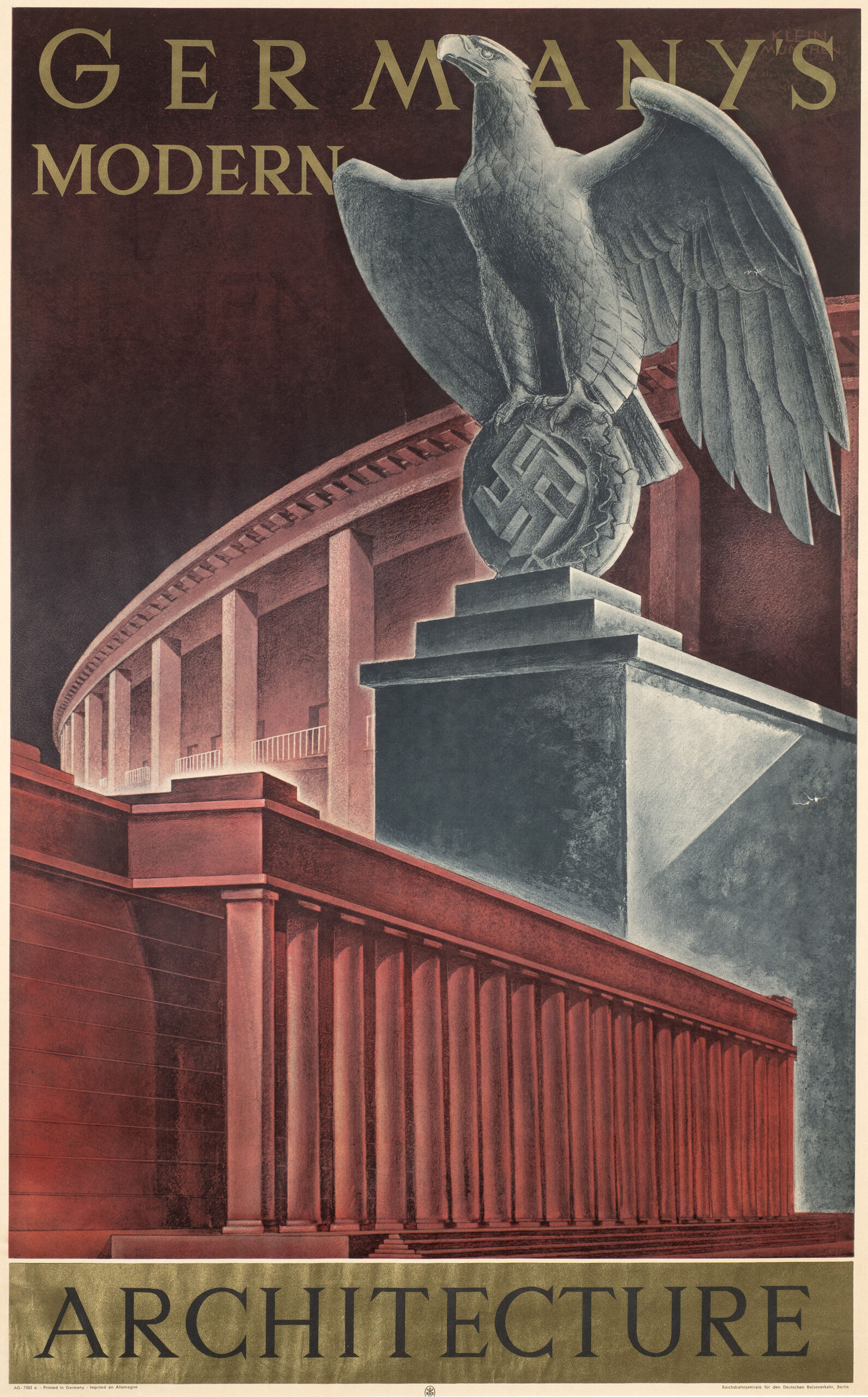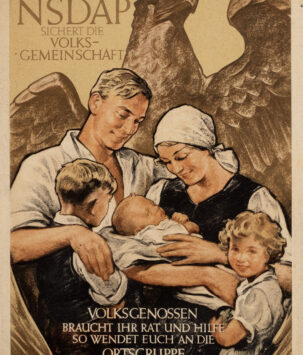Germany’s Modern Architecture
Tourism poster promoting Germany’s new developments in architecture. Fascist architectural design took inspiration from Ancient Rome and was intended to serve as awe-inspiring references to the great classical world as well as an expression of the regime’s infallible might. Taking the form of Stripped Neoclassicism in Germany as typified by Albert Speer’s works, its buildings were deliberately designed to be austere, intimidating and larger-than-life in order to project authority, commanding both fear and awe in equal parts from its beholders. Through its synthesis of modernism and classicism, the style sought to articulate a powerful political ethos oriented towards the future yet equally grounded in tradition. This ethos is best encapsulated in a redevelopment plans for Berlin, which would be renamed Germania. Speer’s architecture is sometimes described as being ‘Wagnerian’, reflecting the grandiose and monumental scale of Richard Wagner’s operas, which employed mythological, heroic and epic themes, often drawing from Germanic and Norse legends. The Third Reich’s intended future capital was indeed conceived as a great Wagnerian spectacle that would capture the glory of this Germanic Reich for a thousand years to come. These plans never came to fruition with Germany’s defeat in the war, yet strives have been made towards its resurrection digitally.
Upon Hitler’s ascension to power in 1933, he immediately embarked on a grand cultural crusade to reinvigorate Germany and kindle a new national consciousness, central to which was architecture. The many public projects planned and undertaken by the Nazi government reflects this philosophy of constructing the so-called ‘aesthetic state’, understood as the “concentrated modern intellectual movement to revitalize the radical Hellenic tradition of the polis as the site of a beautiful or good life”, according to Chytry (2018).
Urban planning in fascist philosophy is driven by an ethos centered around the cultural vitality of its citizens, which stands in stark contrast to the utilitarian nature of capitalist urban development programs which, in its reckless pursuit of efficiency, result in sprawls of little aesthetic nor spiritual quality or flow throughout. In the Gesamtkunstwerk (total work of art) that is the fascist nation-state, its citizens are not only never far from their spiritual tradition as expressed through architecture, but constitute a part of it.
The Reichsautobahn is a perfect example of such centrally planned, culture-oriented public works emblematic of fascist regimes, focused on endowing their citizens with a spiritual connection to the nation through experiencing its environment. A central purpose for the Reichsautobahn, aside from simply serving as logistical infrastructure, was to unify the nation by enabling Germans to explore Germany and its natural beauty. Landscaping was essential to the planned nationwide highway system, calling on architects, rural planners, ecologists and plant sociology experts to contribute to the project. Native vegetation was to be preserved across the nation with the intent of providing travelers within the Reich a genuine experience of the landscape. Such radically forward-thinking ideas about environmentalism, its relationship to human welfare and the regime’s commitment to elevate the spiritual livelihood of its citizens are an oft-overlooked aspect of fascist ideology.
Sources:
Chytry, J. (2018). The Aesthetic State. A Quest in Modern German Thought.
Free shipping on orders over $50!
- Satisfaction Guaranteed
- No Hassle Refunds
- Secure Payments
Tourism poster promoting Germany’s new developments in architecture. Fascist architectural design took inspiration from Ancient Rome and was intended to serve as awe-inspiring references to the great classical world as well as an expression of the regime’s infallible might. Taking the form of Stripped Neoclassicism in Germany as typified by Albert Speer’s works, its buildings were deliberately designed to be austere, intimidating and larger-than-life in order to project authority, commanding both fear and awe in equal parts from its beholders. Through its synthesis of modernism and classicism, the style sought to articulate a powerful political ethos oriented towards the future yet equally grounded in tradition. This ethos is best encapsulated in a redevelopment plans for Berlin, which would be renamed Germania. Speer’s architecture is sometimes described as being ‘Wagnerian’, reflecting the grandiose and monumental scale of Richard Wagner’s operas, which employed mythological, heroic and epic themes, often drawing from Germanic and Norse legends. The Third Reich’s intended future capital was indeed conceived as a great Wagnerian spectacle that would capture the glory of this Germanic Reich for a thousand years to come. These plans never came to fruition with Germany’s defeat in the war, yet strives have been made towards its resurrection digitally.
Upon Hitler’s ascension to power in 1933, he immediately embarked on a grand cultural crusade to reinvigorate Germany and kindle a new national consciousness, central to which was architecture. The many public projects planned and undertaken by the Nazi government reflects this philosophy of constructing the so-called ‘aesthetic state’, understood as the “concentrated modern intellectual movement to revitalize the radical Hellenic tradition of the polis as the site of a beautiful or good life”, according to Chytry (2018).
Urban planning in fascist philosophy is driven by an ethos centered around the cultural vitality of its citizens, which stands in stark contrast to the utilitarian nature of capitalist urban development programs which, in its reckless pursuit of efficiency, result in sprawls of little aesthetic nor spiritual quality or flow throughout. In the Gesamtkunstwerk (total work of art) that is the fascist nation-state, its citizens are not only never far from their spiritual tradition as expressed through architecture, but constitute a part of it.
The Reichsautobahn is a perfect example of such centrally planned, culture-oriented public works emblematic of fascist regimes, focused on endowing their citizens with a spiritual connection to the nation through experiencing its environment. A central purpose for the Reichsautobahn, aside from simply serving as logistical infrastructure, was to unify the nation by enabling Germans to explore Germany and its natural beauty. Landscaping was essential to the planned nationwide highway system, calling on architects, rural planners, ecologists and plant sociology experts to contribute to the project. Native vegetation was to be preserved across the nation with the intent of providing travelers within the Reich a genuine experience of the landscape. Such radically forward-thinking ideas about environmentalism, its relationship to human welfare and the regime’s commitment to elevate the spiritual livelihood of its citizens are an oft-overlooked aspect of fascist ideology.
Sources:
Chytry, J. (2018). The Aesthetic State. A Quest in Modern German Thought.




